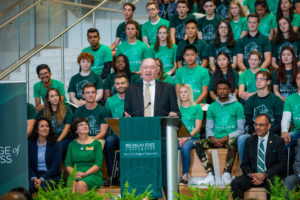
John Hollenbeck was selected to represent Broad College faculty and speak at the Minskoff Pavilion ribbon-cutting event last semester.
With over 35 years at MSU, John Hollenbeck, Eli Broad Professor of Management, has personally been a part of the university’s growth and transformation over the decades. He originally came to Spartan country as a freshly graduated Ph.D. at the age of 26, seeking to gain experience and collaborate with the prominent faculty. He’s been developing an impressive career here ever since.
Hollenbeck is a renowned, award-winning scholar in the realm of team dynamics and work motivation who has published more than 60 articles and book chapters on these topics. Through his academic research, he has worked with military branches, athletic teams and scientists. In the classroom, he works with Broad Spartans of all levels, from undergraduates to Ph.D. students.
This month’s episode of the Spartan BizCast features Hollenbeck sharing tactics for working with students of all levels, giving highlights of some of his research and explaining how businesses should continue to think about team dynamics as the world continues to embrace technology innovations.
Broad News: When working with students — from undergrads to Ph.D. students — how do you tailor the material on teams to these various audiences?
Hollenbeck: You have to segment the audiences based on their needs. So, Ph.D. students are not there to learn how to leverage the knowledge base at work; they are there to learn how to contribute new ideas to the knowledge base. The other audiences all want to learn how to apply the knowledge base but come with vastly different experiences.
Freshmen have no real experience with what I would consider “real teams.” They’ve likely only been on teams led by adults or been a part of unmanaged teams, with no real structure. I try to use examples that will resonate with them and explain how real business teams are not like most student group teams.
MBA students are the easiest to work with because they all have some real experience, three to five years, and it is all very similar experience. They can bring that to the table, and you can leverage that experience in the classroom. Sometimes they think what I’m teaching is common sense, so I try to break things down and bring them into the lab to put them in a team setting. This paves the way for true learning.
With executive education students, the challenge is that they have a ton of experience, but it is all wildly different. You have to be careful to structure [time in the classroom] so that they are not just arguing with each other. They can be a little less open-minded based on the wealth of experience that they’re bringing in, but they are easy to engage because they know that 99% of their problems are HR-related.
Overall, knowing where students are and where they need to be is the key to being an effective teacher.
Broad News: Have you found through your research that there is a “fatal flaw” that people working on teams get wrong time and time again?
Hollenbeck: Absolutely. One is that there’s a lack of structure going in. It’s ironic, but the single most important thing in teamwork is individual accountability: you doing your own job. Planning is everything, and describing roles in advance and making sure everyone agrees upon the roles is how teams can win. Even a bad plan that you can adapt and adjust is better than no plan. Teams try way too often to wing it as opposed to really sitting down and planning it.
Stemming from that is when people do other people’s jobs. Major workload imbalances in teams happen when people try to do it all themselves because nothing is good enough for them, or other people are too slow, or they don’t trust others, or whatever. People need to think about how to interact with others and make them feel included and valuable.
Broad News: As some employees want the flexibility to work from home or work remotely, how does this impact team dynamics?
Hollenbeck: I think a lot of organizations are pulling back from that because a lot of creativity comes from face-to-face communication and impromptu meetings in hallways. Real-time collaboration can happen over virtual teams, but only if you have a live, face-to-face interaction, like through a live video call.
But it depends on how you define “virtual team.” If you take away verbal expressions, things can be misinterpreted. If a team is working remotely and relying only on email communication, that team is going to be a disaster.
To hear more from Hollenbeck on his management research expertise, tune in to this month’s episode of the Spartan BizCast, available now.




